If you’ve traditionally mapped out your website strategy in an Excel spreadsheet, PowerPoint deck, or oops, you haven’t ever formally done that before – then I’ve got a blueprint template to share with you that I think will intrigue you.
What you’ll get:
Big Picture – See your entire web eco-system in a single view. I don’t know about you, but I sometimes struggle to understand how everything works together unless I can physically see it all on a single page.
Cohesion – As a consequence of seeing everything laid out in a single view, it’s much easier to figure out how to connect everything into one cohesive story and customer experience. It also helps you see what it’s like to move through the sales funnel from your customers’ point of view.
Focus – This approach doubles as a shiny-object deflector. Everything you and your team work on next year will fit neatly into one of 3 buckets. With a solid plan, there’s no room for distractors.
No Gaps – What aren’t you thinking about? What did you forget? This blueprint ensures all the major bases are covered.
Curious yet?
The 5-Minute Website Strategy
First, open up your favorite mind mapping tool. If you don’t already have one, my favorite is MindMeister. (Not affiliated with them, I just like them.)
A mind mapping tool is the only way to complete this exercise. A sheet of paper or whiteboard won’t be big enough for what you’re about to do. And drawing tools like Visio and PowerPoint will make this exercise too unwieldy.
In the center of your blank mind map, write down the No. 1 objective of your website:
- Generate revenue or donations
- Generate leads
- Reduce costs
But make it specific. As in, generate $300M in revenue.
From there, add these 3 prongs:
- Marketing
- Engagement
- Conversion
Right now, your mind map should look like this:
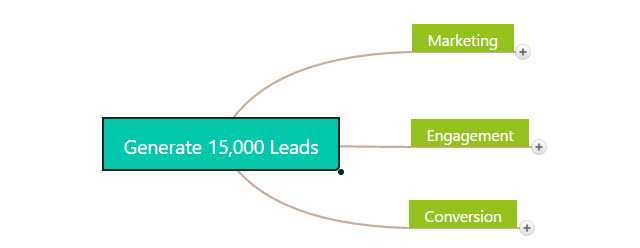
The Top of the Sales Funnel
How will you get people TO your website?
Start adding each and every marketing channel you use (or will use) to drive new or repeat customers to your website. I’ve listed a handful of examples below, but your list probably includes other channels such as affiliate marketing, tradeshows, billboards, mailers, guy standing on corner twirling a sign, etc.
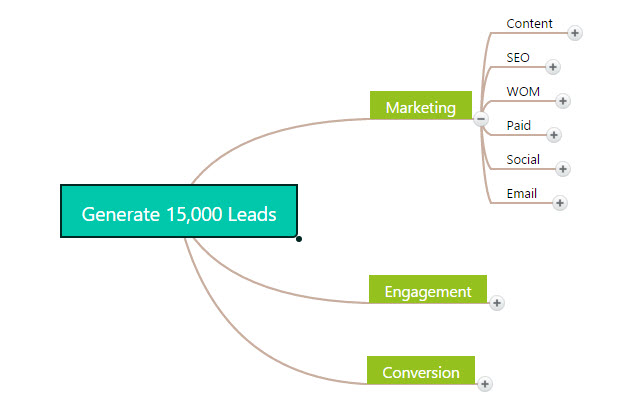
Don’t add any prongs to your marketing channels just yet. You’ll do that later.
The Middle of the Sales Funnel
How will you get people to STAY on your website (or come back)?
Next, add these 3 prongs to Engagement:
- Tools
- Storytelling
- Surprise & Delight
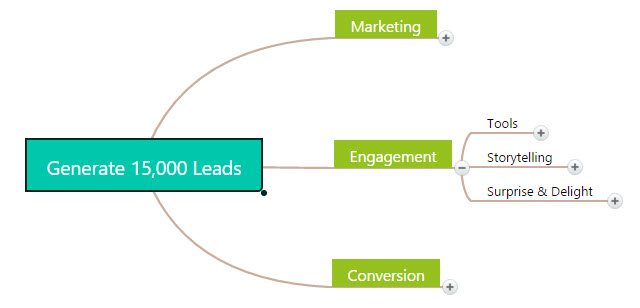
Tools – using the term loosely – includes anything your customers might interact with: games, quizzes, ROI calculators, estimators, wish lists, contests, personalization, self-service tools, message boards / forums, case studies, etc. This is how you will entertain them, inform them, support them, and/or get them to come back for more.
Storytelling is the narrative of your brand – told through messaging, words, pictures, videos, slideshows, colors, and anything else that evokes emotion. Simply, what is the story you want your customers to take away?
Surprise & delight doesn’t happen by accident. Make sure you have a spot for it in your roadmap and budget. I’ve got another post with ideas for surprising and delighting your customers.
If the primary purpose of a tool or piece of content is to generate a lead, result in a donation, create a sale, or reduce costs — save those. They’ll go in the Conversion bucket.
The Bottom of the Sales Funnel
How will you get people to TAKE ACTION on your website?
Add these 2 prongs to Conversion:
- Persuasion
- Optimization
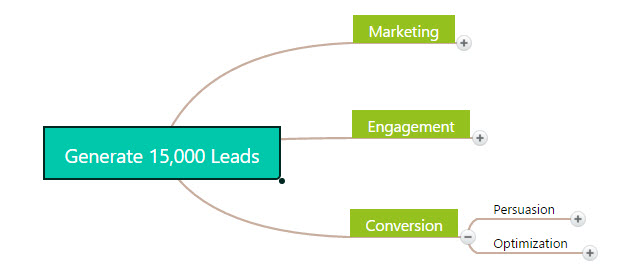
Persuasion includes every behavioral psychology “trick” in the book that convinces your customers to take action: social proof, scarcity, authority, reputation, loss aversion, and on and on.
Practically, persuasion tactics take the form of coupons, secret sales, customer ratings & reviews, testimonials, limited time offers, bonus gifts, limited quantities, quantity discounts, a solution to their problem, etc. Google “conversion persuasion” for more ideas.
Optimization. Because launching never means done. Here is where you’ll put your strategies for A/B testing, usability enhancements, accessibility enhancements, and performance optimization (e.g., reduce page load times). The bottom of the funnel isn’t the only area where you’ll want to conduct A/B testing or evaluate usability — but it should be happening here at minimum.
As you work through this exercise, you may find that the line between Persuasion and Optimization is too blurry for your organization. If that’s the case, combine them into one “Persuasion & Optimization” bubble and go from there.
Now Take Your Roadmap to the Next Level
Now that you have the framework in place, next comes the roll-up-your-sleeves part. And the part that takes more than 5 minutes (sorry!).
Every organization is different, so it’ll be up to you decide what the next level of prongs look like. Maybe you organize them by area of the site, target audience, product, industry, or user goal.
If there isn’t an obvious way to do this, don’t worry about coming up with the buckets now. Document all of the known tactics first, then organize them into logical groups later.
Once you have all the tactics in place, next identify the key activities for each, such as:
- Discovery / research
- Strategy
- Benchmark
- Audit
- Plan
- A/B test
- Measure
- Maintain
- Refresh
- Build
- Rebuild
To get the gears in your brain turning, here is what a Conversion roadmap might look like for a B2B consulting organization’s website:
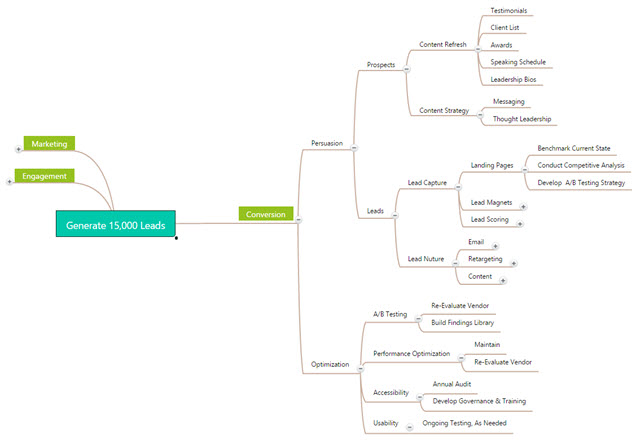
Keep returning to your mind map throughout the year — to add more detail, color-code completed projects, add parking lot ideas, or break it off into new mind maps. Many mind mapping tools allow you to share your maps with others, so you could even use it as a communication tool for your team or across departments.